| Pages:
1
2 |
bulerias1981
Oud Junkie
    
Posts: 763
Registered: 4-26-2009
Location: Beacon, NY
Member Is Offline
Mood: John Vergara Luthier Lord of the Strings instrument making and repair
|
|
New "Tarab oud" completed
Hello all. Just finished another oud, and almost done with a third. Here is what I call "Tarab oud" for a lack of a better name. Shallow bowl depth
(175mm), long scale (614).
◾Scale = 614
◾Face width = 360
◾Face length = 515
◾Bowl depth = 175
◾Classic Syrian pattern main rosette = 109
◾Classic Syrian pattern small rosettes = 40 x2
◾Bowl from Dark America walnut and mahogany
◾Rosewood pegs, rosewood fingerboard
◾Wide grain spruce top
◾Bone nut
◾Pick guard from walnut
◾Walnut bridge w/ bone cap
◾Bone cap on peg box
◾Finished with antique oil
◾Pegbox from walnut and maple (prevents pegbox from splitting)
This oud has very quality sophisticated tone. Video/audio to come. It has that old tarab sound, hence the name.
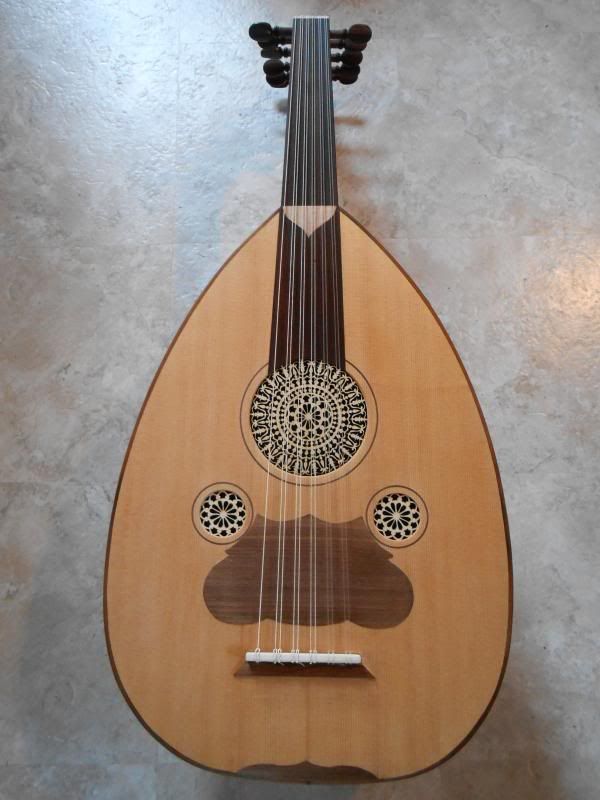
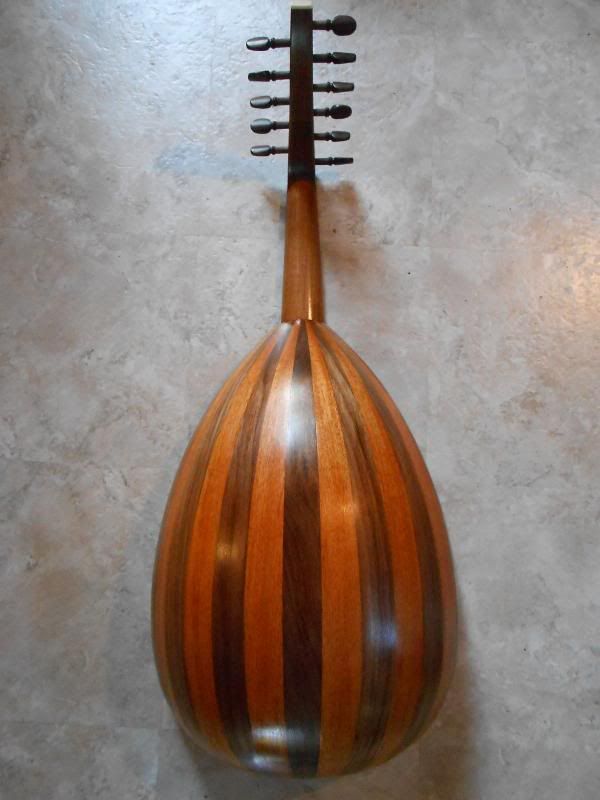
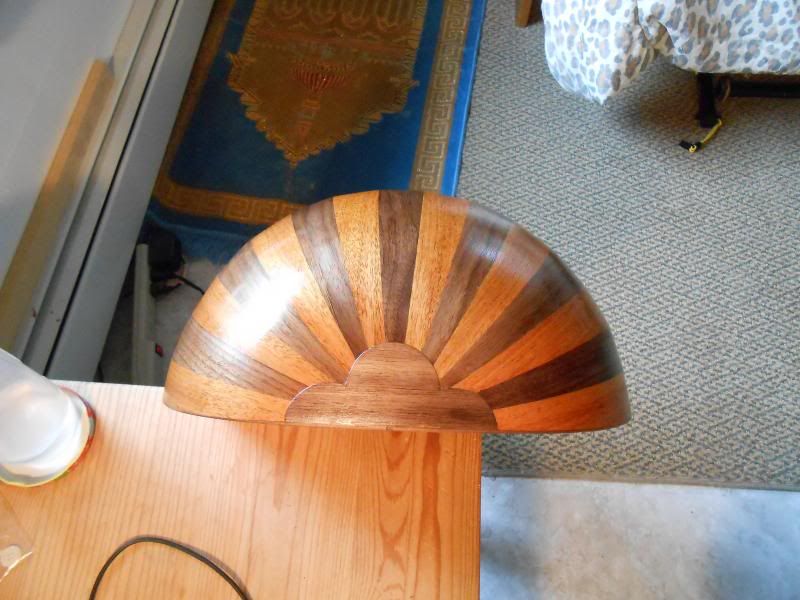
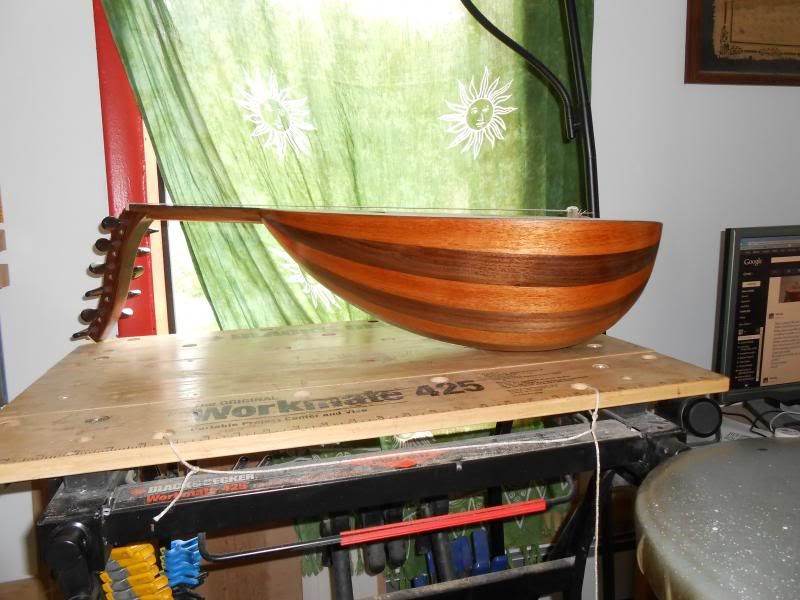
|
|
|
Jody Stecher
Oud Junkie
    
Posts: 1353
Registered: 11-5-2011
Location: California
Member Is Offline
|
|
Ooh, that's lovely, John. I look forward to hearing it. What's your thinking about the bone nut, since the strings are passing through the holes in
the wood bridge and are not vibrating on the nut (or are they?).
|
|
|
bulerias1981
Oud Junkie
    
Posts: 763
Registered: 4-26-2009
Location: Beacon, NY
Member Is Offline
Mood: John Vergara Luthier Lord of the Strings instrument making and repair
|
|
Thanks Jody. The strings end at the bone nut, the grooves help the string stay in place, and if the grooves are filed correctly, the string travels
through the nut without pulling on the wound strings.
|
|
|
Jody Stecher
Oud Junkie
    
Posts: 1353
Registered: 11-5-2011
Location: California
Member Is Offline
|
|
Quote: Originally posted by bulerias1981  | | Thanks Jody. The strings end at the bone nut, the grooves help the string stay in place, and if the grooves are filed correctly, the string travels
through the nut without pulling on the wound strings. |
The strings are actually traveling through holes in the nut rather than through holes in the bridge below? I can't quite tell from the photos.
Your ouds keep getting better (and they started out very good). I sent you a u2. have a look.
|
|
|
bulerias1981
Oud Junkie
    
Posts: 763
Registered: 4-26-2009
Location: Beacon, NY
Member Is Offline
Mood: John Vergara Luthier Lord of the Strings instrument making and repair
|
|
I guess I don't understand your question. There is nothing unusual about how the strings pass through the bridge and nut on this oud.. all
standard.
Thanks for the U2U.. I made the spelling correction.. wahogany!! Which wouldn't be false, the bowl is a mixture of walnut and mahogany!!
|
|
|
hamed
Oud Junkie
    
Posts: 293
Registered: 1-18-2005
Location: Seattle, Washington
Member Is Offline
Mood: Iss'al rouhak
|
|
very nice oud, you must be very proud.
is this oud for sale?
|
|
|
Brian Prunka
Oud Junkie
    
Posts: 2916
Registered: 1-30-2004
Location: Brooklyn, NY
Member Is Offline
Mood: Stringish
|
|
I think Jody is referring to the bridge, not the nut.
Strings will sometimes dig into the bridge wood at the top, I would expect that having a bone top to the bridge would prevent that. I don't think it
would change the tone much.
|
|
|
bulerias1981
Oud Junkie
    
Posts: 763
Registered: 4-26-2009
Location: Beacon, NY
Member Is Offline
Mood: John Vergara Luthier Lord of the Strings instrument making and repair
|
|
Yes Hamed, the oud is for sale. If interested, please PM me.
Ah, ok Brian.. well yes, the bone on top of the bridge is to prevent the strings from digging into the top of the bridge and imprinting it. I guess
that's what Jody was asking.
|
|
|
hamed
Oud Junkie
    
Posts: 293
Registered: 1-18-2005
Location: Seattle, Washington
Member Is Offline
Mood: Iss'al rouhak
|
|
Ok Boss i just sent you an email.. For some reason i am unable to send a U2u
Thanks
|
|
|
Jody Stecher
Oud Junkie
    
Posts: 1353
Registered: 11-5-2011
Location: California
Member Is Offline
|
|
Quote: Originally posted by Brian Prunka  | I think Jody is referring to the bridge, not the nut.
Strings will sometimes dig into the bridge wood at the top, I would expect that having a bone top to the bridge would prevent that. I don't think it
would change the tone much. |
Ah, someone who can read what I meant instead of what I absent-mindedly wrote. Yes I meant the top of the bridge. I guess that's technically "a
saddle" on other string instruments. Sorry for the confusion. A "senior moment" perhaps.
|
|
|
bulerias1981
Oud Junkie
    
Posts: 763
Registered: 4-26-2009
Location: Beacon, NY
Member Is Offline
Mood: John Vergara Luthier Lord of the Strings instrument making and repair
|
|
Yeah, you can call it a saddle.. I call it a cap. Either is fine I suppose.
|
|
|
fernandraynaud
Oud Junkie
    
Posts: 1865
Registered: 7-25-2009
Location: San Francisco, California
Member Is Offline
Mood: m'Oudy
|
|
Beautiful! That big rosette/shamsa is stunning!
|
|
|
SamirCanada
Moderator
     
Posts: 3404
Registered: 6-4-2004
Member Is Offline
|
|
That bridge is made of a rare wood called "walone" a kind of human walnut breed which grows a bone structure. 
Read more about it here http://www.telegraph.co.uk/news/worldnews/1569156/Tree-man-who-grew...
Jokes asside thats a Sweet Oud brother, congradulations on completing it.
@samiroud Instagram
samiroudmaker@gmail.com
|
|
|
Adel Salameh
Oud Junkie
    
Posts: 235
Registered: 4-18-2008
Member Is Offline
Mood: No Mood
|
|
Hello everybody...
John this is a very nice simple oud...also well done for the great repaire which you carried on Tawfiq Nahat oud...that oud sounds very Arabic..
regarding Al Tarab oud,
what is the length of the bowl?
the width of the soundboard?
what is the height of the strings were the neck joins the body?
why using a wide grain spruce for the soundboard despite the fact that you can easily got very close grain these days....some of my old nahat ouds
have wide grain and they sound fantastic...so it's not a rule but would like to hear from you regarding this point... how old is your soundboard?
I like the bone on the bridge which protect the bridge however it does change the sound not very much.. but you have to get used to it...
walnut is my favorite wood for the oud...mixed with the mahogany.. it reminds me of the old nahat ouds...
are you thinking of making ouds with 60 cm string length? without of course loosing sustain and bass??
Regarding the saddle I do not like it despite the fact that it's used sometimes on some ouds...it's a matter of taste...
where can we see these instruments?
good luck and carry on with the great job which you are doing,
Adel
|
|
|
bulerias1981
Oud Junkie
    
Posts: 763
Registered: 4-26-2009
Location: Beacon, NY
Member Is Offline
Mood: John Vergara Luthier Lord of the Strings instrument making and repair
|
|
Hi Adel,
Thanks for the comments and questions. Here we go..
The bowl length is 515
The width of the soundboard is 360
The height of the Low C strings at the neck joint under the string is 2mm,
The height of the High C strings at the neck joint under the string is 1.5!
The action is LOW! It can be adjusted to be higher, but its very comfortable as I like it as a player myself. I find when it plays and sounds good as
this one does, you don't have to think about ideas or playing, it just all happens because you waste less energy.
About wide grain, its something that I prefer to Arabic sound. Nahat used wide grain because tight grain wasn't available. They didn't order wood from
the Carpathian mountains, or German Sitka spruce with 100 grain per inch! I am intent on achieving that best of that old sound which we love in Nahat
and believe this is an important reason why Arabic ouds sound Arabic. On Turkish ouds I prefer tighter grain. There is the element of echo.. which is
separate from resonance, they shouldn't be confused. When I do a soundboard for an Arabic oud I want to eliminate all chances of echo. I want a lot of
resonance, I want bell tones, I want a crisp and punchy sound with depth, but I do not want echo. Wide grain helps with this. Echo is when you deaded
the string after its been played and it continues to ring on. This is okay for Turkish instruments. Even on violins and cellos I've seen amazing
sounding instruments with wide grain. Even some of the great sounds can be attributed to a soundboard in multiple pieces (3, 4, 5) with wide grain, or
even pine! So I'm also not opposed to soundboards in multiple pieces. The great sound of Nahat is the absence of echo, is it not? That's what I
usually find.
The soundboard was cut in the mid 80's, which gives an ample amount of drying time. I personally think if a soundboard is more than 3 years, its
actually fine.
About the bone, I think its something esthetically beautiful, and highly functional. Take a look at Simon Shaheen's Nahat oud restored by his brother
Najib Shaheen, and you'll see a bone cap on the bridge. If Simon Shaheen uses it, it should be more than acceptable and not hard to get used to at
all. I usually add something to the top of most of my bridges, such as a combo of bone and turquoise or even ebony or rosewood.
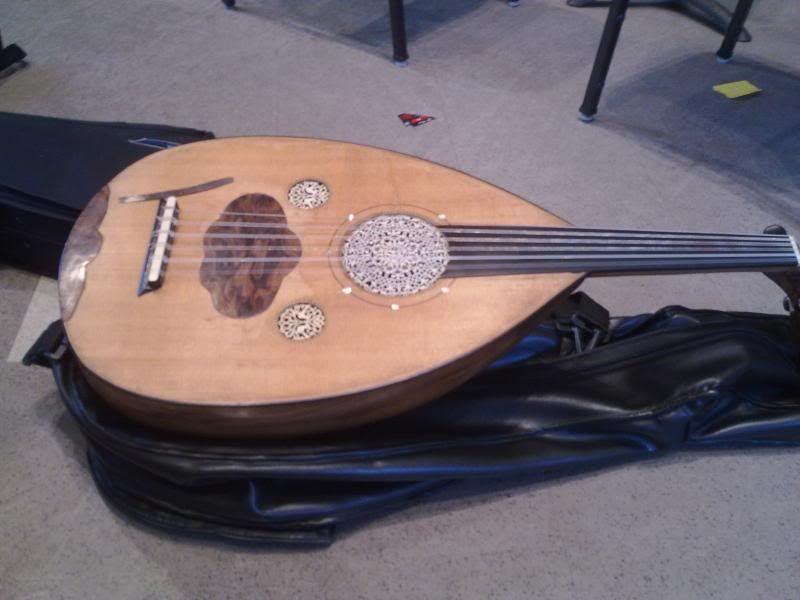
When I made the bowl, like most of them, I keep in mind the example of Nahat. The purpose of using walnut and mahogany was to get that Nahat look.
About making ouds with 60cm, I have before. I actually prefer 60cm, although to achieve a great powerful sound, I find it easier when the scale is
61.4ish.
I live in NY, anyone here is welcome to try my instruments.. I'll be very hospitable of course 
|
|
|
Adel Salameh
Oud Junkie
    
Posts: 235
Registered: 4-18-2008
Member Is Offline
Mood: No Mood
|
|
Thanks John for your reply and for your invitation... yes I should make it to the USA...
51.5 cm the length of the bowl.. yes I have a 1920 Abdo nahat oud with 52 cm bowl length... it does produce a huge sound..a lot of bass... however I
Have other model of Abdo with 50 cm length...I prefer this as it's easier to hold the instrument... 36 cm width of the soundboard is fine too..
regarding the height of the strings.. it's a great result which you have achieved...it makes it very easy to play....on this point I would like to ask
you about a common problem which we have with most ouds... neck pending... many of the traditional ouds have this problem ...some in few months
..others in few years... I have seen some ouds with adjustable neck...I find this unnatural and strange on such an instrument....the traditional dowel
is not enough to keep the neck in place and stable... that is what some luthier claims...which I do not believe this as I have seen some old nahat
ouds almost a 100 years old instrument and the action is still perfect especially Abdo....
I know both Matthias Wagner and Wolfgang Fruh uses a huge metal screw to join the neck with the body and I tend to agree with them... the result is a
stable neck which does not move...a nice action and I do not have to worry about it...
you have a very interesting point of view regarding wide grain...like I have said ..most of the nahat ouds which I have seen have a wide grain to
produce, bassy ,haunty , deep , mellow sound...this is the traditional sound as we know it...however I have seen the last oud which Wolfgang made
and it has a very tight grain soundboard ..yet he has achieved the same result that we are after...
again I was very surprised with a multiple pieces soundboard which Matthias has used on his last oud....8 pieces and I thought it will never work...
100 year old soundboard.. the result is great too....
regarding the bone on the bridge... I think it's an excellent idea and it does protect the bridge...you can see this on some of Tawfiq nahat ouds... I
am not so keen on the piece of wood stuck on the soundboard behind the bridge...only my taste...
how thick is your soundboard ? bass and treble...
did you apply the same barring system to this oud as the one you did on Tawfiq Nahat
I believe you should have some of your ouds here in Europe...some of my students will be interested in these ouds
thanks again and good luck with your work...
Adel
|
|
|
bulerias1981
Oud Junkie
    
Posts: 763
Registered: 4-26-2009
Location: Beacon, NY
Member Is Offline
Mood: John Vergara Luthier Lord of the Strings instrument making and repair
|
|
You are welcome anytime ya Adel, and thank you again for the comments on this post. Very good topics for discussion here.
About the length of the face, when I was making the mould, I did realize that 515 was a bit long even for my taste. That's why the height of the bowl
is less than normal. It is shallow at a depth of 175 instead of 215 or 220, like most other ouds with a long bowl.. there is also evidence that
shallow improves response time.. although, any maker knows that a shallow bowl is more difficult to make, because not every rib is the same shape as
each one alters after the first. I prefer a shallow bowl even on smaller bowls, as its closer to the body and always more comfortable than a
half-round pattern. The shallow bowl feature is something I believe in and will pretty much be employed on all my ouds from now on unless someone
wants otherwise.
About the acoustical aspect of large patterns versus small.. take the viola for example. There are some really large models which ate 17" which is
considered enormous! The average adult size is about 15". The goal of the maker is to produce a sound that a 17" makes in the size of a 15".. It's
very difficult and challenging. So that's how I see this matter of small scale lengths. I'd say I'd like to consistently make a sound like a 620mm
scale in the size of a 588. Which is actually possible, but not as easy. If a maker decides to make a large scale oud, it won't be too hard to bring
out a big sound in which the basses are boomy and seem to have bark and bite.
Moving to the neck joint problem. I personally don't mind the neck dowel system, but under a few circumstances. I also don't mind a metal rod or screw
(as long as I know its there!) But I prefer the traditional method. It's easy to repair for one. However, there are very very few examples of necks
made by the old makers that didn't have issues or neck resets. They've almost all had issues. This is correct. One thing we have to remember about the
Nahat dynasty is that they were expert woodworkers, furniture makers, but they weren't players. So they didn't know what it feels like when the action
rises. Listen to old recordings of Farid Al Atrash. He was a short man, maybe 5'5 in height, not to large hands. For sure most of his ouds had large
scale lengths like 615.. and in the recordings you'll notice when he tunes you hear the pegs chattering really loud. So the pegs were poorly fitted,
and the action was high just to name a few issues. As great as Nahat was, I don't think there was a big emphasis on setup like we have today when it
comes to the Arabic oud.
When the maker does the neck joint, he has to make sure to get the neck angle perfect. What does this mean? It means to be able to predict the initial
rising of the strings once the oud is completed and the strings are fastened on and tuned. So as an example, I make sure the neck angle is slightly
lower than perfection. Because I know the strings will pull up at the neck, and even the platform where the bridge usually rises 1mm sometimes, and
you have to add that on to the total action height. There is also the perfection of the neck joint. We must know that both surfaces that join are 100%
flat without gaps! That's very important too. So taking these things into consideration, with a nice hardwood dowel thick enough, it should produce a
solid joint that will last a long time. The grain of the wood is also important in regards to strength and durability.
The piece of wood on the back is meant to stop the soundboard from receiving arm sweat. Its .4mm thick, easy to install, easy to remove.. certainly
harmless acoustically since it sits on top of the tail block.
About Mr. Matthias making a soundboard in 8 pieces, I actually think that's great for Arabic sound!!!
My soundboard thickness is never the same. I base it on different factors.. Like the size of bowl, the length, the width.. Also the stiffness of the
individual piece of spruce. Usually for me, the thickness can be anywhere from 1.7 to 2.1mm. This oud here, "Al Tarab" is a uniform 1.9. I prefer
uniform thicknesses on the soundboard. The bracing system is a bit different from the Tawfiq Nahat that you saw in an earlier post.
I would love to get my instruments out to Europe. Perhaps in a year I'll have more and there might be someone I can ship them to there so they can be
available to the market there. I'm almost done with another.
Thank you
|
|
|
Adel Salameh
Oud Junkie
    
Posts: 235
Registered: 4-18-2008
Member Is Offline
Mood: No Mood
|
|
Thanks John for your answer and patient...I appreciate it...
what I am writing here is my point of view as a player and have had the chance to see and play many ouds in my life...I found after many years that
the best size of the oud is 36 cm width , 50 cm length and 60 cm string length...
we both agree that we can achieve a substantial result with 60cm... it's not easy but we can have nice bass and loud instrument with nice
sustain...and you do not have to fight with the instrument...
I do not remember playing an oud with 17.5 cm bowl ...but can believe you when you say that its more responsive....this is the reason why we should
have at least a video of this oud...
regarding the neck joint ... you have explained it very well... and I have heard from many makers that it's a very difficult job ...it's so hard to
got the right angle ..some new instrument do buzz a little bit but the buzzing should go when the instrument is settled....once hope ...
I do believe that we should have schools or colleagues were students can study oud making like what we have here in Europe....here you study
instrument making... the traditional oud is going no where and to keep this instrument a life you should have quality instrument produced and
encourage more people to play it... the only way to achieve this is to have schools ...I have seen some of the ouds which are made by Arab makers who
have studied in Europe and their instruments is superior to the one we are producing in the Arab world...
another point is most students and many players can afford to spend 1000 Euro on an oud...you have many makers who are selling their ouds at this
price... however when the student or the player wants a better instrument and he or she has 2000 Euro to spend on an oud ... their choice is very
limited and in most cases their is not much different in the quality... sound and craftsmanship..so you pay double the price but not a better
instrument...
not many of my students nor players can pay 3500 Euros + vat to got a great oud...
I raise these issues here as we have so many makers on this forums,players and oud students...
best wishes
|
|
|
jdowning
Oud Junkie
    
Posts: 3485
Registered: 8-2-2006
Location: Ontario, Canada
Member Is Offline
Mood: No Mood
|
|
Nice looking oud John.
When you stated earlier in this thread that the Nahat family used wide grain sound board wood "because tight grain wasn't available" is this a
recorded historical fact or just an opinion?
I ask because I find it hard to believe that the Nahat luthiers did not have access to a plentiful supply of fine grained wood or two piece
soundboards - better even than material generally offered today by commercial luthier supply enterprises (where cosmetic appearance may be a
significant factor in their grading standards) - if that is what they wanted to use for their ouds.
As member Adel Salameh has confirmed earlier (subjectively), sound board grain width alone likely does not have any great influence on the tonal
attributes of a completed instrument?
|
|
|
bulerias1981
Oud Junkie
    
Posts: 763
Registered: 4-26-2009
Location: Beacon, NY
Member Is Offline
Mood: John Vergara Luthier Lord of the Strings instrument making and repair
|
|
Thanks John.
Well to answer your question, I have to ask questions. Where in the Middle-East would they have obtained tight grained spruce from? Certainly Jamil
George wouldn't find it growing in his native Egypt and certainly none of the Nahats would have in Syria. Also when we think of Nahat, we must think
first that they were fine furniture makers. There is no need for tight grain spruce. Also, we don't find tight grained spruce on any of their
instruments, let alone in 2 pieces. The classic Nahat sound that we all crave is a result of using what they had local to them. And it ends up working
out great that way. It created a sound, and a style around it that embodies what we know as the classic Arabic genre. Now, Nahat might have had access
to tight grain spruce via trade from sources abroad, but who knows, maybe at a premium they weren't willing to pay. If they did have access to it, we
should see examples of it somewhere in their work or their contemporaries.
Definitely the grain width does not have great influence on the tonal properties on its own. But when I use the wide grain top, I can more or less
calculate what I'm going to do based on the other variable parameters... such as, the bowl shape and size, scale length, bowl thickness, number of
soundholes, stiffness of the soundboard and so on. With these factors I construct the plan of how to establish brace locations, brace heights and so
on. If it were a tight grain spruce, the face thickness will vary, and so will many other things. But for me, if its an Arabic model in mind, the main
concern is echo. Which is why I believe wide grain in multiple parts is ideal. I haven't done a soundboard in 8 parts yet, but I'm inclined to doing
it.
|
|
|
jdowning
Oud Junkie
    
Posts: 3485
Registered: 8-2-2006
Location: Ontario, Canada
Member Is Offline
Mood: No Mood
|
|
So, did the Nahats ever use spruce for their sound boards - tight grained or otherwise? If spruce as a species was not a locally available wood to the
Nahats and they were unwilling to use - for whatever reason - the readily available regionally imported varieties of timbers then what did they use
for their oud soundboards - locally available cedar perhaps? Has anyone actually microscopically analysed the surviving Nahat sound boards to
determine the wood species? Surely important questions if that 'classic sound' said to be embodied in the Nahat style of oud is to be properly
replicated today? Just curious.
|
|
|
Adel Salameh
Oud Junkie
    
Posts: 235
Registered: 4-18-2008
Member Is Offline
Mood: No Mood
|
|
Hello again...
Abdo nahat did use a Tight grain on some of his ouds...the 1918 Abdo oud which I have has a soundboard with tight grain....the sound is melloww,
soft,tense and very warm Earthy bass...
on the contrary, the wide grain 1920 Abdo nahat oud which I have is louder, punchy aggressive sound....a lot of volume... not very warm compare to the
1918...
I have seen this again recently on modern ouds made by Wolfgang Fruh in Paris....he made me an oud in 2007... with wide grain... I must admit I was
disappointed that he used wide grain for the soundboard.. however I love that oud and I played it in all my concerts for many years ....it has a very
nice bass and mellow sound...however one of my students got his instrument recently from Wolfgang and he did use tight grain.. the result is a mellow
sweet bass, very intense, earthy sound....the sound is very Arabic...so it's the maker who can got this out of an instrument..I have seen this on both
Abdo nahat ouds and wolfgang ouds...
I had owned once a nahat oud with the bowl made of ebony , and this wood is not native to our region... so they did import wood from outside...
best of luck,
|
|
|
Ronny Andersson
Oud Junkie
    
Posts: 724
Registered: 8-15-2003
Location: Sweden
Member Is Offline
Mood: No Mood
|
|
Quote: Originally posted by jdowning  | So, did the Nahats ever use spruce for their sound boards - tight grained or otherwise? If spruce as a species was not a locally available wood to the
Nahats and they were unwilling to use - for whatever reason - the readily available regionally imported varieties of timbers then what did they use
for their oud soundboards - locally available cedar perhaps? Has anyone actually microscopically analysed the surviving Nahat sound boards to
determine the wood species? Surely important questions if that 'classic sound' said to be embodied in the Nahat style of oud is to be properly
replicated today? Just curious.
|
Pine species, Cypress species and Cedrus libani are regional available tree species. I wish someone could do an analysis...I have never believed in
the spruce ¨thing¨.
Best wishes
Ronny
|
|
|
Oud Freak
Oud Junkie
    
Posts: 291
Registered: 11-23-2007
Member Is Offline
Mood: Oud Jerk 
|
|
Good work bulerias! Wish I could try it. It would be nice to try this oud with "choir technique" fingers (looooooool).
Keep it up and best of luck.
Hope this oud the future buyer takes good care of it and offers you the price it deserves.
Cheers!
|
|
|
Alfaraby
Oud Junkie
    
Posts: 796
Registered: 9-18-2009
Location: Holy Land
Member Is Offline
Mood: Cool
|
|
Sorry John dear, but this is not true. Since I know you and your credibility, I wonder how could you write such a decisive, assertive point of view,
without knowing the real true facts.
First, a short historical reminder: French troops occupied Syria in 1920, after the League of Nations put Syria under a French mandate. For the next
26 years, Syria was subject to French influence, until the French troops were evacuated in April 1946. Even today we can still detect some of this
influence in Syria & Lebanon, just like the British mandate on Palestine & Jordan has done. The cooperation between the occupier and the
occupied was/is a matter of foregone conclusion, if I may say so, therefore an active trade developed through the 26 years of the French mandate on
Syria.
Abdo Nahat used to import items for his workshop, diffidently not only for ouds. He contracted a French manufacturer of the spinning Bride & Groom
mechanism for his wedding jewelry boxes. He imported industrialized processed wide bone "sheets" from France, since the natural cow bone is narrower
than he'd need. Some say he sailed to France very early in the 20th C. for this purpose, but this may be only an ill-founded hearsay. He also might
have imported &/or bought from local wood traders rare species for decorating his items and ouds. So why not import or buy imported spruce or even
cedar ?
Furthermore, the first significant wave of Syrian immigrants arrived in the United States in 1880. Many of the earliest Syrian Americans settled in
New York, Boston, and Detroit. Just a reminder, even Abdo Nahat himself & his family immigrated to Brasil in 1938. The vast majority of these
immigrants were Christians, some Jews and rarely Moslems. So why couldn't he have relatives who might have helped him to import from both Americas ?
In the early 20th century, Tartus, one of the biggest port cities on the Syrian coast, knew a rapid development momentum, after it became the main
path for import of goods to Iraq. On the other hand a railway connected between Damascus and Haifa, the major port in Palestine those days, bringing
imported "hot out of the oven" goods right into the Damascene markets. So why not some spruce inter alia ?
I have seen plenty throughout the years. Adel have seen more for sure.
Well, I think photos would answer your wondering. Are these soundboards tight enough ?
Sleep well talented young man !
Yours indeed
Alfaraby
[file]27029[/file] [file]27027[/file] [file]27031[/file]
alfarabymusic@gmail.com
|
|
|
| Pages:
1
2 |